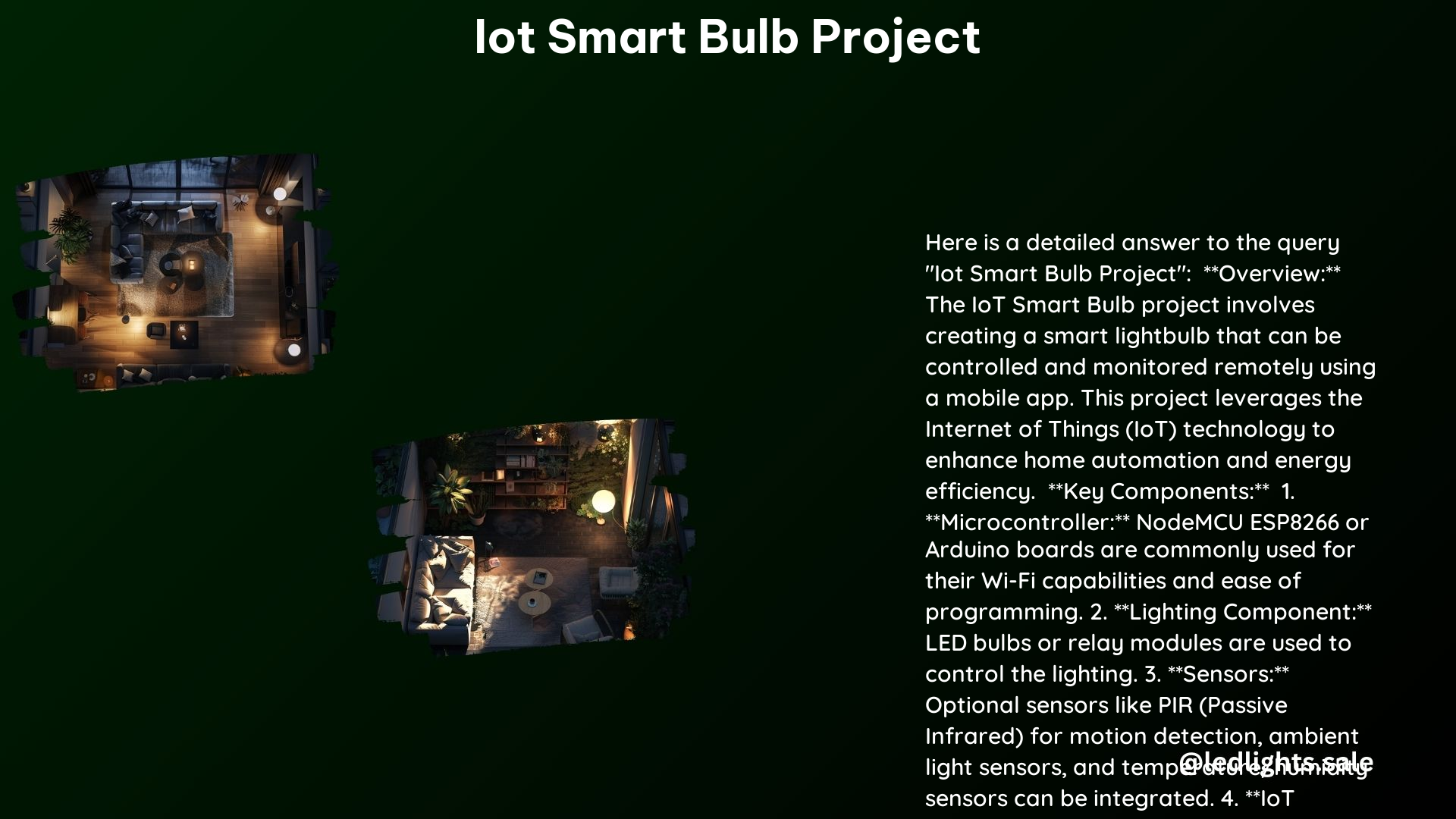The IoT (Internet of Things) Smart Bulb Project is a captivating endeavor that allows you to create a cutting-edge smart lighting system that can be controlled remotely using a mobile app. This comprehensive guide will delve into the key components, technical specifications, and step-by-step instructions to help you bring your IoT smart bulb project to life.
Hardware Requirements
NodeMCU ESP8266
The heart of this project is the NodeMCU ESP8266, a low-cost microcontroller board with built-in Wi-Fi capabilities. The ESP8266 features a 32-bit Tensilica Xtensa LX106 CPU, operating at a clock speed of 80MHz, and comes equipped with 128KB of RAM and 4MB of flash memory. This powerful yet affordable microcontroller is perfect for IoT applications, as it allows seamless integration with various sensors and actuators.
Relay Module
To control the bulb, you’ll need a relay module. Relays are electromechanical switches that can handle high-voltage and high-current loads, making them ideal for controlling devices like light bulbs. The relay module used in this project typically features a 5V coil and can switch up to 10A at 250VAC or 30VDC.
LED Bulb
The LED light bulb is the primary component that will be controlled in this project. It’s important to choose an LED bulb that is compatible with the voltage and current specifications of your setup. A standard 5-10W LED bulb should work well for most applications.
Power Supply
To power the NodeMCU and the relay module, you’ll need a 5V power supply. This can be a USB power bank, a wall adapter, or a dedicated power supply module.
Breadboard and Jumper Wires
A breadboard is used to easily connect the various components, while jumper wires are used to make the necessary connections between the NodeMCU, relay module, and the bulb.
Software Requirements

Arduino IDE
The Arduino IDE is the software used to write and upload the code to the NodeMCU ESP8266 board. It provides a user-friendly interface and a wide range of libraries to simplify the development process.
Blynk App
Blynk is an IoT platform that allows you to create a custom user interface to control your IoT devices remotely. The Blynk app provides a drag-and-drop interface for designing your control panel, and it seamlessly integrates with the NodeMCU board.
Circuit Connections
- Connect the positive and negative terminals of the 5V power supply to the breadboard.
- Connect the positive and negative terminals of the relay module to the breadboard.
- Connect the “IN” pin of the relay module to the D0 pin on the NodeMCU.
- Connect the positive terminal of the LED bulb to the D0 pin on the NodeMCU.
Blynk App Setup
- Create an account on the Blynk app and log in.
- Create a new project and choose the NodeMCU as the device.
- Set the connection type to Wi-Fi.
- Add a Button widget and set the output pin to D0.
- Upload the code to the NodeMCU board.
Code
- Download the required libraries: Blynk Library and ESP8266 support package.
- Open the Arduino IDE and add the downloaded libraries.
- Write the code to control the bulb using the Blynk app.
- Upload the code to the NodeMCU board.
Working
- Connect the NodeMCU board to your local network.
- Upload the code to the ESP8266 board.
- Use the Blynk app to control the bulb remotely.
Technical Specifications
NodeMCU ESP8266
- Microcontroller: 32-bit Tensilica Xtensa LX106 CPU
- Clock Speed: 80MHz
- RAM: 128KB
- Flash Memory: 4MB
- Wi-Fi: 802.11 b/g/n
Relay Module
- Coil Voltage: 5V
- Maximum Switching Current: 10A
- Maximum Switching Voltage: 250VAC or 30VDC
LED Bulb
- Power Consumption: 5-10W
- Voltage: 220-240VAC
Advantages
- Remote Control: The IoT Smart Bulb Project allows you to control the bulb from anywhere using a mobile app, providing unparalleled convenience and flexibility.
- Automation: You can schedule the bulb to turn on and off automatically, enabling energy-efficient and hands-free lighting control.
- Energy Efficiency: By monitoring and controlling the bulb’s energy consumption remotely, you can optimize energy usage and reduce your carbon footprint.
Applications
- Home Automation: The IoT Smart Bulb Project can be integrated into a comprehensive home automation system, allowing you to control lighting throughout your home remotely.
- Industrial Automation: This technology can be applied in industrial settings, where remote control and monitoring of lighting systems can improve efficiency and reduce maintenance costs.
- Public Lighting: IoT-enabled smart bulbs can be used to control and manage streetlights and other public lighting systems, enabling remote monitoring and optimization of energy usage.
References
- Learnelectronicsindia.com: IoT Smart Bulb using NodeMCU and Blynk App
- Dusuniot.com: How to Using IoT in Smart Lighting
- Idew.org: Build Smart Lightbulb | Internet of Things Project
- YouTube: Control Electric Bulb from Mobile | IOT Projects | Home Automation
- Instructables.com: GLO: IoT Smart Light
